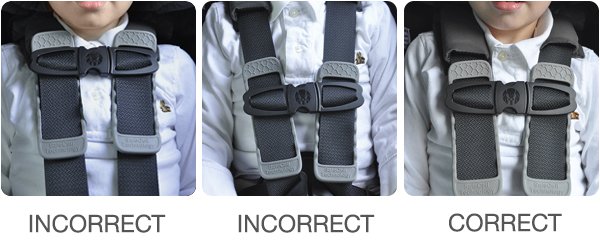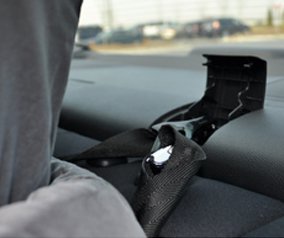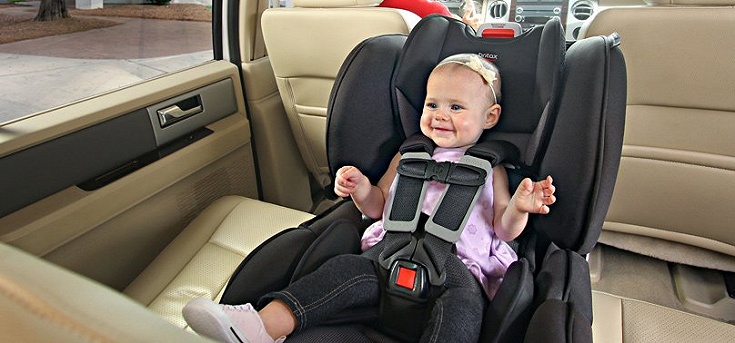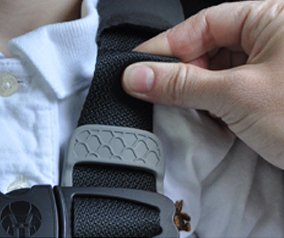No parent ever wants to get it wrong when it comes to their child’s safety, but studies have shown that 3 out of 4 car seats are used incorrectly. We know that car seats offer your child the best protection during a crash when they’re installed and used correctly, so we’ve created a list of some of the most common misuses with quick tips for how to correct them.
Misuse #1: Forward-Facing Too Soon
At Britax, we believe that children should travel rear-facing for as long as possible – ideally until they are at least two years old and their developing neck muscles have grown stronger. Rear-facing seats protect the neck and head by distributing the force of a frontal collision along the back of the seat. We believe that a less exciting view for a little person is a small compromise if it provides a safer ride. The American Academy of Pediatrics agree – visit their site to find out more.
Misuse #2: Loose Harness Straps
We know that some children don’t like being strapped in too tightly, but we do recommend that you keep the harness nice and snug. A perfect harness sits comfortably in a straight line without sagging and doesn’t allow any slack. To make sure the harness is snug enough, try the simple Pinch Test.
Misuse #3: Incorrect Harness Strap Height
All children are different and grow at different rates. That’s why it’s important for you to keep an eye on how the harness height fits their body. For the best protection in case of a crash, the tops of the harness straps should be located as follows:
- Rear-Facing: At or slightly below your child’s shoulders
- Forward-Facing: At or slightly above your child’s shoulder
Misuse #4: Incorrectly Positioned Chest Clip
As the name implies, the proper position for the chest clip is on your child’s chest, at armpit level. When properly positioned, this clip helps keep the harness straps up on your child’s shoulders so they can do their job to keep your child secure during a crash.

Misuse #5: Loose Car Seat Installation
We know that a car seat can only protect your child if it has been installed securely. A securely installed car seat should not move more than 1 inch side-to-side or front-to-back at the belt path. If you have trouble installing your car seat securely, we suggest that you try the following:
- Try installing the car seat in another seating position in your vehicle. For example, if you can’t install it securely in the rear center seat, try an outboard position.
- Try installing the car seat using another installation method. For example – if you’re not able to get a secure installation using the LATCH system, try installing with the vehicle seat belt and tether.
- Consider seeking help from a certified child passenger safety technician. You can find a technician or car seat check event in your area by visiting SafeKids.org.
Misuse #6: Exceeding the LATCH Weight Limits
When it comes to installing car seats, using the LATCH (Lower Anchors and Tethers for Children) system is a popular choice. But many caregivers aren’t aware that the lower anchors have weight limits. And those limits can be different depending on which vehicle and car seat you have. So if you choose to install your child’s car seat using lower anchors, be sure to check both the car seat user guide and your vehicle owner’s manual for the weight limits, and reinstall the car seat using the vehicle seat belt when your child reaches the limit. For more on the LATCH system and lower anchor weight limits, visit About LATCH.
Misuse #7: Not Using the Top Tether

At Britax, we know that every inch counts when it comes to protecting your child during a crash. That’s why we recommend that you use the top tether whenever possible. When forward-facing, the use of a top tether can reduce the distance that your child’s head moves forward during a crash by four to six inches.
Misuse #8: Installing Rear-Facing at the Wrong Angle

When children are rear-facing in a car seat, it’s important for the seat to be installed in a reclined position to help keep baby’s head and neck supported and airways clear. The recline angle is especially important for young infants who are still developing head and neck control. So when you’re installing your little one’s car seat, be sure to refer to the user guide or labels on the side of the seat and install the seat at the recline angle indicated.
Misuse #9: Using a Pre-Owned Car Seat
At Britax, we believe it’s important for every family to make smart choices that fit their unique needs and lifestyle. But when it comes to pre-owned car seats, we encourage you to use caution. For your child’s safety, as well as your own peace of mind, we recommend using a pre-owned car seat ONLY if you can answer all of the following questions: Has the car seat been in a crash? Has it been recalled? Are the user guide and all parts and pieces present? Are all the labels attached?
Misuse #10: Using an Expired Car Seat
We believe that when you put your child in a car seat, you should be able to trust that it will provide the best protection possible during a crash. We know that environmental factors like sunlight and heat can cause the materials in a car seat to degrade over time, so we recommend replacing car seats after they expire. All Britax car seats have a product life between 6 – 10 years, depending on the model. This information can usually be found on a label on the car seat or in the user guide. For more information about car seat expiration dates, see our FAQs.

